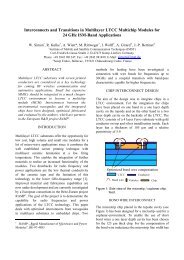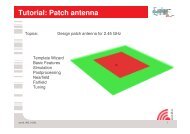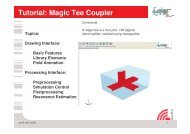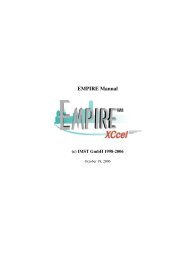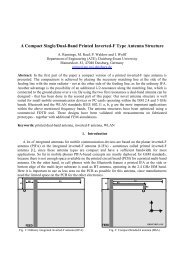RECTANGULAR WAVEGUIDE TO PLANAR STRUCTURE ... - Empire
RECTANGULAR WAVEGUIDE TO PLANAR STRUCTURE ... - Empire
RECTANGULAR WAVEGUIDE TO PLANAR STRUCTURE ... - Empire
Create successful ePaper yourself
Turn your PDF publications into a flip-book with our unique Google optimized e-Paper software.
<strong>RECTANGULAR</strong> <strong>WAVEGUIDE</strong> <strong>TO</strong> <strong>PLANAR</strong> <strong>STRUCTURE</strong> TRANSITIONS FOR ANTENNA APPLICATIONS<br />
Winfried Simon, Sybille Holzwarth, Andreas Wien, Ingo Wolff, Fellow, IEEE<br />
Institute of Mobile and Satellite Communication Techniques (IMST)<br />
Carl-Friedrich-Gauss-Straße 2<br />
D-47475 Kamp-Lintfort<br />
Germany ; E-Mail: simon@imst.de<br />
ABSTRACT<br />
Nowadays, more and more antenna designs are focussing on planar structures. Latter antennas have the advantage that<br />
they are small in dimension and cheap to manufacture compared to horn antennas. Especially for radar applications in<br />
the industrial sector these properties are very interesting, surely in combination with low cost waveguide modules.<br />
Necessary for combining such planar structures and waveguide modules are often small transitions from rectangular<br />
waveguides to planar structures which have a good electric performance and can easily be manufactured. To allow<br />
symmetrical feeding of antennas, transitions to striplines realising a 180° phase difference in each direction would be<br />
ideal. Another important point is to design a transition that does not disturb the radiation pattern of the antenna due to<br />
leakage radiation. This paper presents the design and realisation of such novel transitions for the feeding of a small<br />
antenna array operating at 24 GHz. Additionally, a planar transition from a rectangular waveguide to a coplanar line for<br />
70 GHz is presented. For designing the transitions, 3D electromagnetic field simulations have been performed, using the<br />
Finite Difference Time Domain (FDTD) method [1]. The comparison between measurement and simulation results is<br />
excellent.<br />
INTRODUCTION<br />
The well known transitions from waveguides to planar circuits often require modifications of the waveguide. The E-<br />
plane probe transition [2] consists of a microstrip line on a dielectric substrate inserted into the waveguide. A<br />
waveguide backshort must be placed in a certain distance behind the probe to achieve good transmission properties. So,<br />
the waveguide extends over the top of the planar substrate and puts restrictions upon the layout and the antenna design.<br />
In case of the ridged waveguide transition [3], the waveguide also extends on both sides of the planar design. It is not<br />
possible to use such transitions for an antenna feed because the radiation pattern would be disturbed significantly. In<br />
addition, the manufacturing costs are very high due to the necessary modifications of the waveguide. The transition<br />
from a rectangular waveguide to a coplanar line introduced in [4] is a first approach to a planar transition. Here a<br />
substrate is placed on top of the waveguide and a coupling structure on top of the substrate and two patches beneath the<br />
substrate form the transition. In the transitions presented in this paper a substrate is also placed onto the waveguide to<br />
achieve a planar transition. Yet, the coupling structure is different compared to the transition described in [4]. To<br />
achieve a low radiation leakage at the top side, a patch underneath the substrate combined with a slot in the ground<br />
plane is used. The symmetrical feeding of antennas with 180° phase shift in both directions is realised with two slots in<br />
the ground plane.<br />
<strong>RECTANGULAR</strong> <strong>WAVEGUIDE</strong> <strong>TO</strong> MICROSTRIPLINE TRANSITION<br />
The transition from the rectangular WR42 waveguide to the stripline for the feeding of the antenna array has been<br />
designed in several steps. In the first step a transition from the waveguide to a microstrip line has been designed. The<br />
left side of Fig. 1 shows this transition (A) consisting of a substrate placed on top of the waveguide. The field is coupled<br />
through a slot in the ground plane of the microstrip line to a patch placed on a substrate in the waveguide. This substrate<br />
is fixed with conductive glue to the top substrate. The field distribution of the TE-10 mode in the waveguide matches<br />
good the field distribution between the sides of the patch and the waveguide walls. Necessary for the correct distribution<br />
is a λ / 4 width of the patch. For the adjustment of the frequency, the width of the patch and the length of the slot in the<br />
ground plane have been optimised with FDTD simulations. In addition, the length of the microstrip line behind the slot<br />
has been used for optimisation. In the next step two microstrip lines have been placed on top of the substrate (B). The<br />
coupling is realised by placing two slots above the gaps between the patch and the waveguide walls. Due to the<br />
overlapping of the microstrip lines over the slot, an offset between the lines is necessary. In the simulation results of
these two transitions, depicted on the right of Fig.2, can be seen that a 15 dB bandwidth larger than 3 GHz was<br />
achieved, and that the transition B couples symmetric to both microstrip lines.<br />
Slot<br />
Substrate<br />
Slots<br />
Substrate<br />
Waveguide<br />
Patch<br />
Waveguide<br />
Patch<br />
A<br />
B<br />
Fig. 1. Schematic view of the transitions from the rectangular waveguide to the microstrip lines<br />
[dB] 0<br />
-10 |s11| A<br />
|s21| A<br />
|s11| B<br />
|s21| B -20 |s31| B<br />
Slots<br />
Substrate<br />
-10<br />
-20<br />
Waveguide<br />
C<br />
Patch<br />
-30<br />
22 24 26 28<br />
Frequency [GHz]<br />
Fig. 2. Schematic view of transition C and Simulation results for transitions A and B<br />
In the last step the transition has been designed symmetrically (left side of Fig.2) with one microstrip line above the<br />
centre of the waveguide. Due to the symmetry of the transition a 180° phase shift is achieved between both ends of the<br />
microstrip line if the TE 10 mode is applied. For a good impedance matching the width of the microstrip line is reduced<br />
in the region above the waveguide. This microstrip line is used for the feeding of a 2*4 patch antenna array operating at<br />
24.125 GHz. The patch prevents the slots from radiating to the top (antenna structure) and disturbing so the radiation<br />
pattern of the antenna array. This was investigated by measurements and simulations of the farfield, with and without<br />
the coupling patch. Fig.3 shows the reflections at the waveguide port of the transition in combination with the patch
array. The measurements of two different prototypes (m1,m2) are compared to the simulation results. The –10 dB<br />
bandwidth of the complete system ( transition and the antenna ) is about 5 GHz while the radiation leakage is below<br />
−33 dB, due to the patch in the waveguide. It has by this no effect on the farfield of the antenna. The agreement<br />
between simulation and measurement is very good and a good reproducibility is achieved as can be observed by m1 and<br />
m2 in Fig.3. Additional information about the antenna part is given in [6].<br />
Scattering parameters [dB]<br />
0 |s11| sim<br />
|s11| m 1<br />
-5<br />
|s11| m 2<br />
-10<br />
-15<br />
-20<br />
20 22 24 26 28<br />
Frequency [GHz]<br />
Fig. 3. Simulation and measurement results for transition C<br />
<strong>RECTANGULAR</strong> <strong>WAVEGUIDE</strong> <strong>TO</strong> CO<strong>PLANAR</strong> LINE TRANSITION<br />
The planar transition from a coplanar line to the rectangular waveguide at 70 GHz consists of a substrate placed on top<br />
of the waveguide. The waveguide is operated in the TE10 mode. To achieve a coupling between the waveguide and the<br />
coplanar line, a slot is used. The inner conductor of the coplanar line is shortened at the backside of the slot (see Fig. 4).<br />
A bridge at the end of the coplanar line suppresses unwanted modes.<br />
Fig. 4. Planar transition from a rectangular waveguide to a coplanar line<br />
For the design of this transition the 3D FDTD field simulator <strong>Empire</strong> has been used [5]. This simulator takes into<br />
account all 3D coupling effects and allows the display of field distributions in any plane.
Fig. 5 shows on the left side the magnitude of the electric field at 71 GHz in the region of the slot . The field strength is<br />
indicated by colour from red (strong field values) to green (low field values), and the direction of the field is indicated<br />
by arrows. One can observe that the field distribution in the slot corresponds very well with that of the TE10 mode in<br />
the waveguide. The desired frequency range of the transition can be selected by modification of the slot length. To<br />
achieve a good adaptation to the 50 Ohm coplanar line, the slot has been connected unsymmetrically to the inner<br />
conductor. In addition, the adaptation and the bandwidth can be modified by the width of the slot. All these parameters<br />
have been optimised with the FDTD simulator. The optimisation goal was a 10 dB bandwidth from 69 GHz up to 74<br />
GHz . Viaholes placed under the blue line (see Fig.4) extend the waveguide into the substrate and prevent the transition<br />
from lateral radiation.<br />
The right side of Fig. 5 shows the simulation results after optimisation. The reflections are below –10 dB from<br />
68.75 GHz up to 75 GHz while the transmission loss is below 0.7 dB.<br />
Scattering parameters [dB]<br />
0<br />
-5<br />
-10<br />
-15<br />
-20<br />
-25<br />
-30<br />
-35<br />
6,50E+010 6,75E+010 7,00E+010 7,25E+010 7,50E+010<br />
|s12|<br />
|s11|<br />
-40<br />
65.0 67.5 70.0 72.5 75.0<br />
Frequency [GHz]<br />
0<br />
-5<br />
-10<br />
-15<br />
-20<br />
-25<br />
-30<br />
-35<br />
-40<br />
Fig. 5. Electric field in the coupling slot (left) and simulation results of the transition (right)<br />
CONCLUSION<br />
Two transitions from rectangular waveguides to planar structures have been presented. They are based on the coupling<br />
between metal structures on the top and the bottom of the substrate. Both transitions do not require any modifications of<br />
standard waveguides and can easily be used for the feeding of antenna structures. Especially the transition to the<br />
microstrip line has been optimised with respect to a low radiation leakage for the feeding of an antenna array operating<br />
at 24 GHz. Measurements of the reflection at the waveguide port and of the radiation pattern confirm in addition to the<br />
results from the FDTD simulations a good performance of the complete structure.<br />
REFERENCES<br />
[1] Yee, K. S.: "Numerical solution of initial boundary value problems involving maxwell´s equations in isotropic<br />
media." IEEE Trans. Antennas and Propagation. Vol. AP-14, S. 302-307, 1966<br />
[2] T.Q. Ho, Y. Shih: "Spectral-domain analysis of E-plane waveguide to microstrip transitions" , IEEE Trans.<br />
Microwave Theory Tech., Volume 37, pp. 388-392, Feb. 89<br />
[3] W.Menzel, A. Klaassen: "On the transition from ridged waveguide to microstrip", Proc. 19th European Microwave<br />
Conf., pp. 1265-1269,1989<br />
[4] W. Simon, M. Werthen, I. Wolff: "A Novel Coplanar Transmission Line to Rectangular Waveguide Transition",<br />
IEEE MTT-S Intern Symp Digest., pp. 257-260 1998<br />
[5] IMST GmbH, "User and Reference Manual for the 3D EM Time Domain Simulator <strong>Empire</strong>",<br />
htpp://www.imst.de/microw/producs/empire/downloads.html, February 1999<br />
[6] S.Holzwarth, W.Simon, D. Heberling,“Simulation and realisation of a waveguide-fed planar antenna array”, AP<br />
2000




